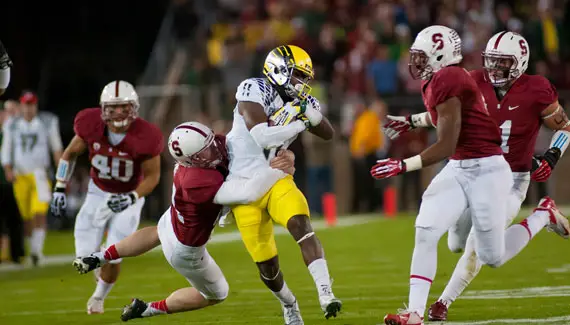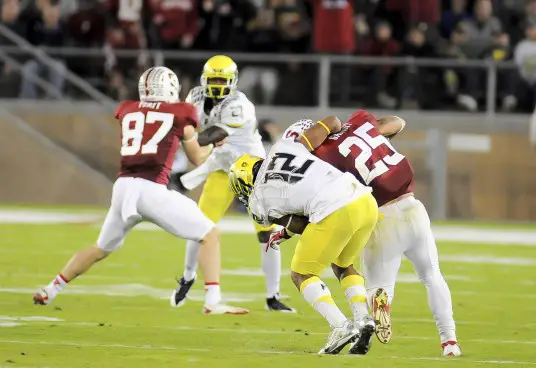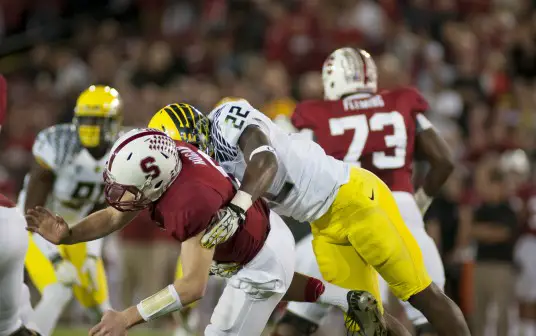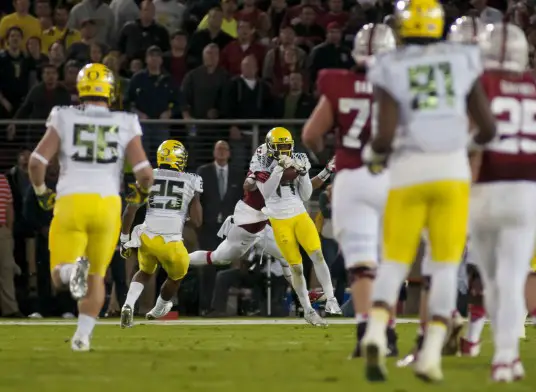Craig Strobeck
The Spread Offense will never work. Stanford’s win over Oregon was clearly evidence of that. “Power Football” will always trump speed and innovation. So give up Ducks, old-school football has and will always prevail.
This is the narrative that emerges following seemingly every Oregon loss. When Oregon loses, the argument never seems to be that Oregon with its quality athletes lined up against another team with quality athletes, and the other team prevailed by outplaying them in a particular game. No, each loss has to serve as evidence that Oregon’s system is a gimmick, and that despite only five losses in the past four seasons, or the fact that over half the teams in college football use some variation of the Spread Offense, there is the prevailing sentiment that soon this will all pass.
I’ve never understood the obsession from those trying to “disprove” the effectiveness of an innovative brand of football as a means to validate a conventional method of play. Why is it fun to advocate against innovation? And how idiotic is it to assume that only one system can prevail as effective?
For whatever reason, Oregon has become the face of those who hate the Spread, or other offenses that use speed, and have their critics agendize every one of their losses to a team like Stanford as proof of the offense’s shortcomings, yet when Stanford loses to Spread teams like Utah or Washington, it is blamed on a multitude of reasons, none of which are ever the system it runs.
Yet that isn’t the only myth that has to be debunked following Oregon’s loss to Stanford. Here are three more prevailing sentiments that have emerged, that need to be dispelled:
1) Stanford is the Best Team in West
The Stanford “best in the west” narrative was the one most of the national writers chose to pull out of Thursday’s game. It was a fun angle to take; no Pac-12 team had defeated Oregon two years in a row since Cal in 2007-08, the last of which coincided with the last season Oregon did not play in a BCS bowl game.
Yes, at present, Stanford appears to have Oregon’s number, but the “best in the west” narrative is a little thin. This season alone, Stanford lost to Utah, needed help to beat Washington, didn’t close well against Arizona State (and for that matter, Oregon, too), and struggled against Oregon State and even Army. That’s a lot of games to have suspect play to be dubbed “best in the west.” Typically, elite teams aren’t struggling to win two-thirds of their games.
At present, the Cardinal are a bad matchup for one of the conference’s perennial powerhouses. They’ve also lost to a six-loss team for two consecutive seasons (we’ll pencil Utah in as one, which they will be if they lose to Oregon on Saturday), while the Ducks haven’t lost to a team that finished with six losses since 2007.
To be an elite program, a team needs to play well every week. Instead, Stanford’s model is playing one-game seasons, saving their energy for their biggest matchups while playing to level of their competition during the remaining weeks. This is best exemplified by Stanford’s quarterback Kevin Hogan, who was 8-of-18 for 88 yards passing against Oregon State, a defense that gave up 411 yards passing to an FCS quarterback, suddenly turning into an elite quarterback as soon as he sees the Ducks across the line from him.
Stanford is not an elite program; their success against Oregon has come by making the Ducks their sole focus, they lack the power to be relevant on a national level. They remind me of another upstart program who was once regularly on the top of the conference a few years ago, who also made a rival the sole focus of their seasons . . .
2) Stanford is Here to Stay (Actually, 2010s Stanford is more like late-90s/early-00s WSU)
While seemingly everyone wants to paint Stanford as a new brand of West Coast elite, evidence that “power football” trumps all, and evidence of the sustainability of Stanford’s program, there are many parallels to draw between Stanford’s current run and that of Washington State in the late-1990s/early-2000s.
Both programs are constantly hounded by questions of whether they could sustain their success given the natural obstacles to doing so. For Washington State, geography; for Stanford, it was academic hurdles.
Yet the most evident parallels for the two programs are in how they approach their seasons. For Washington State, whose rise coincided with a slide in rival Washington, the culture of their program never shifted beyond defining its success by a single game; whether or not they won the Apple Cup. For Stanford, it approaches the season the same way – it lacks the focus to be great week-in and week-out, but it has talented enough players to focus on big games.
A program can win conference championships that way, it can be highly ranked that way, but it will never sustain itself without bigger dreams.
Two ingredients contributed to an eventual decline at WSU: the loss of coaches who helped the program rise, and shifting its recruiting focus from the two- and three-star recruits who built up the program, to swinging and missing on recruiting four- and five-star recruits instead. Stanford has done the same with its recruiting, but will it be able to sustain that model? It seems to think so, which we will find out the probability of, given that there are about 124 other schools that would like to recruit top-tier athletes with excellent academics as well.
As for the coaches, David Shaw has been inquired about by NFL teams (I’m sure a third-consecutive BCS bowl will quiet those rumblings) and defensive coordinator Derek “no, not the receiver for the Titans and Ravens” Mason, is one of the hottest names amongst assistant coaches in college football. How much coaching attrition can Stanford sustain? That will be the difference of whether or not the Cardinal go the way of the Cougars.
3) This is a Program-Defining Loss for Oregon
I heard from many Duck fans that this was the toughest loss to watch since Boise State in 2009, which is fitting because what that game was to Chip Kelly, Thursday’s game was for Mark Helfrich. While Helfrich’s experience came in his ninth game, and not his very first, it was still his first game against a top-five opponent, as a head coach. (Even though Boise was ranked 14th at the time of the matchup, they would finish undefeated and ranked fourth in the nation.)
Both 2009 Boise State and 2013 Stanford were similar in that each time, the opponent managed to steal a win at Autzen Stadium as a heavy underdog the year previous, only to win the following year at home by dominating the game on both sides of the line.
Maybe all it takes is a punch in the mouth to realize what it takes to succeed. Having a stocked cupboard is important, but learning to be a head coach isn’t an automatic process. Chip Kelly would also lose his first game to Stanford, too; yet the following year, he led the Ducks to a big win over Stanford en route to an appearance in the National Championship Game.
Here’s hoping the same holds true for Helfrich and the Ducks. This won’t be a loss that defines them, it will be one that strengthens them going forward.
Related Articles:
Chip Kelly Update: Everything's Good Again ...
Chip Kelly Update: Wailing and Gnashing of Teeth
Shock and Awe -- The Oregon Ducks' Football Hangover Effect
Despite Lopsided Score, Georgia State "Never Stopped Believing"
Hope Springs Eternal for Ducks
Incompetent Pac-12 Officials: How Do You Miss ALL of THIS?
Nathan Roholt is a senior writer and managing editor emeritus for FishDuck. Follow him on Twitter @nathanroholt. Send questions/feedback/hatemail to nroholtfd@gmail.com.




